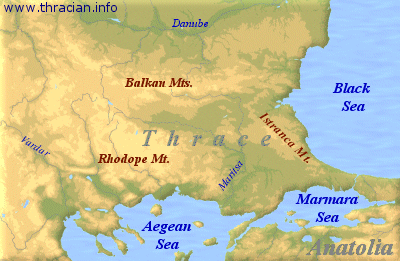Landscape, Tombs and Furniture
It s not trace, it s Thrace!
The world that beyond Turkey s borders could be forgiven for never having heard of Thrace. And they could be forgiven for asking where Thrace is, what happens or happened there and most important of all, is there anything really interesting and worth exploring in Thrace? At its peak Thrace prospered from its position on the main thoroughfare from Byzantium (referred to in later times as Constantinople and Istanbul) and it is thought to have Turkey s oldest inhabited cave around 400,000 years old located at Yarimburgaz.
Landscape
If you were to venture to the top of Vize Hill (in ancient spelling Bisya or Bizye), the capital of ancient Thrace you will be greeted with an astonishing view of the surrounding hinterland. When the casual observer scans the wide plains beneath their vantage point, they will see numerous burial mounds containing tombs. These tombs which are located roughly 1 to 2 miles apart from one another are those of the ancient kings of Thrace.
This style of burial subsequently made its way to Anatolia and then farther on to other areas of the Near East. In Anatolis, the tomb of King Midas himself bears an uncanny resemblance to the Thracians burial tombs!
Tombs
The richness of Thrace s heritage can be found in its burial tomb architecture. A once thriving aristocracy motivated the establishment of Thracic versions of the monumental tombs. During the late Classical and early Hellenistic periods, the Thracian elite with their significant knowledge of Hellenic and Hellenistic architecture, created an effusion of these tombs. It is thought that Thracian locals would let their creative juices flow by experimenting by combining various different architectural features in their designs.
The resulting tombs proved to be among the most evocative funerary complexes at such an early date. Detailed studies of the construction and decoration of these tombs determined that elements of Greek order were to be found. Consequently it would appear that the tombs were very much inspired by Greek architecture. These detailed studies also suggested some influence from the funerary architecture of Asia Minor e.g. the shape of door coverings, iconic style door frames, sliding doors, lantern type roofings, funerary beds and relief decoration of the front of tombs.
Furniture
Furniture has also been found in Thracian tombs. Two rectangular monolithic urns have been found at Mal Pepe and stools were documented at Chichchikova, Naip and Ivanski.
Stools in relief were found in Dolno while painted stools and murals were found in Kazanlak and Alexandrovo.
Items of early
street furniture were also found at Kirkareli in the
form of benches and tables. Invariably of stone construction, the
benches and tables were normally square or rectangular in shape and of
monolithic construction. No actual thrones have been discovered in
Thracian tombs although there is a picture of one on a frieze in the
Kazanlak tomb depicting a woman on a throne.
I hope you find this site helpful.
Wikipedia on Thrace | Thrace in Brittanica Encyclopedia | All About Turkey | Site Sponsors - Auditing App by Auditform and Parking Ticket Machines by Automate.
 Richard
Seneous
Richard
Seneous
Baltimore
Maryland
richard@thrace.info






